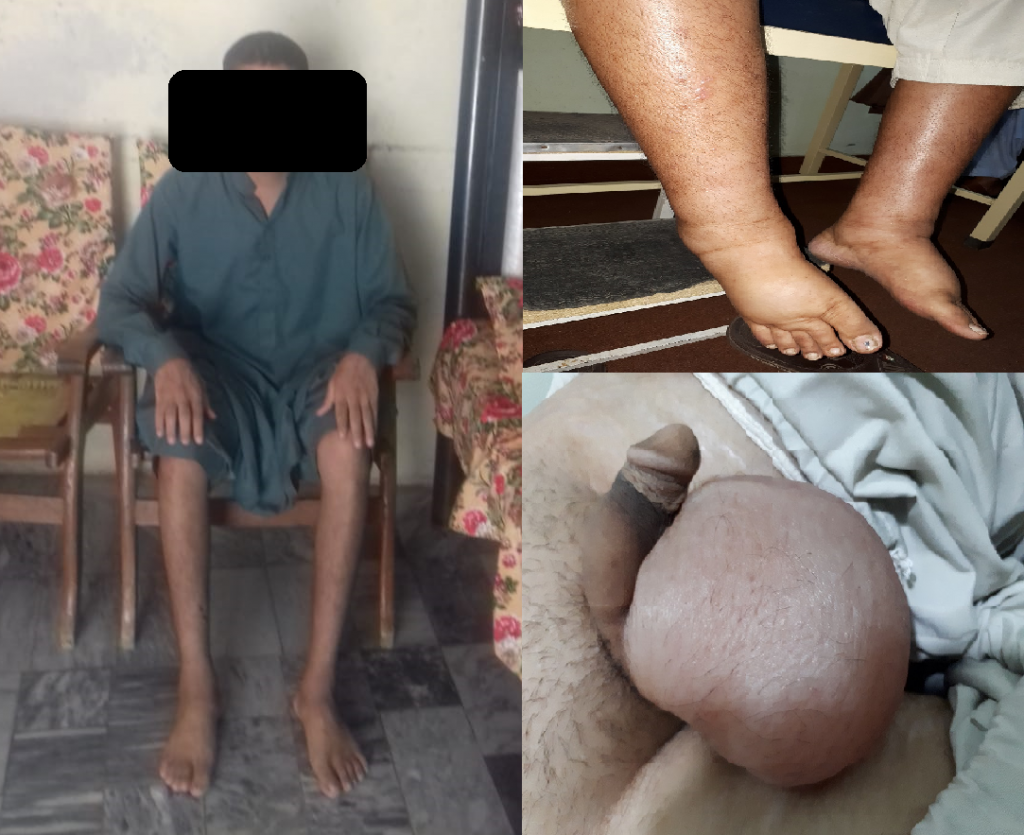Nephrotic syndrome is a clinical syndrome characterized by generalized body swelling as a result of proteins loss in the urine.
Before discussing the key points in the diagnosis and management of nephrotic syndrome, I present here a case scenario of our patient who was admitted with generalized body swelling in our ward.
A young male patient presented with progressive body swelling over the past three months.
He noticed swelling around the eyes (in the early morning) and legs (in the evening that worsened with prolonged standing or sitting).
With time, he developed weight gain, abdominal distension and shortness of breath. The patient denied any history of orthopnea, paroxysmal nocturnal dyspnea, palpitations, and chest pain.
The patient denied any history of a chronic diarrheal state, joint pains, rash, seizures, altered mental status, or visual defects.
Examination of the patient:
The patient had stable vital signs, had marked lower limb pitting edema, periorbital puffiness, ascites (free fluid in the abdomen), marked testicular swelling, and bilateral pleural effusions in the lungs.
The patient was investigated for anasarca.
Blood CP and chemistry were unremarkable. Urinalysis revealed +3 proteins that were quantified and 24-hour urine report showed urinary proteins of 12 gms/24 hours.
Serum Albumin was 1.4 mg/dl and serum Proteins were 4.8 mg/dl. Lipid profile revealed raised LDL and triglycerides.
Chest radiograph showed bilateral pleural effusions. Ultrasound abdomen suggested gross ascites with normal kidneys.
A nephrology consult was requested and he was advised supportive treatment and prednisone at a dose of 1 mg/kg/day.
Before proceeding to the management, let’s answer some of the questions.
How is nephrotic syndrome diagnosed?
What are the causes of nephrotic syndrome in adults?
What are the complications of nephrotic syndrome?
How should we treat nephrotic syndrome?
Diagnosis of Nephrotic syndrome …
It is defined by the presence of
- Heavy proteinuria of 3.5 gms or more in 24 hours
- Hypoalbuminemia of less than 3.0 gm/dl
- Edema
- Hyperlipidemia
What are the causes of nephrotic syndrome in adults?
- Minimal change disease ( also called lipoid nephrosis or nil disease)
- Focal segmental glomerulosclerosis
- Membranous nephropathy
- Amyloidosis
- Diabetes
What are the complications of nephrotic syndrome?
- Protein malnutrition
- Hypovolemia
- Acute kidney injury
- Thromboembolism
- Infections
How do we treat nephrotic syndrome?
Treatment is aimed at:
- Reducing proteinuria
- Minimizing the symptoms
- Avoiding the complications
ACE inhibitors and ARBs (angiotensin receptor blockers) are the time tested medicines that reduce proteinuria
Other medicines that reduce proteinuria include calcium channel blockers like diltiazem and amlodipine.
Also, avoid excessive protein and salt intake. Salt intake should be restricted to less than 2 gms per day.
Symptomatic and supportive treatment includes
- The use of diuretics and salt restriction ( less than 2 gms/ day) to reduce edema
- Add a statin for hyperlipidemia
- Specific therapy includes
- Glucocorticoids
- Immunomodulators
- Risk reduction requires vaccination and aspirin.
Back to our patient with nephrotic syndrome …
Our patient was advised renal biopsy that suggested membranous glomerulonephritis based on the following report:
- All glomeruli show thickening of glomerular basement membrane with spikes on GMS special stain.
- No segmental scarring and mesnagial pproliferation is seen.
- No vasculopathy is seen
- Minimal focal tubular atrophy is seen
- Minimal focal interstitial inflammation and scarring is seen.
- Immunofluorescence revealed moderate-intensity granular immune deposits detected along the membrane in all the glomeruli.
We continued the patient on:
- Angiotensin receptor blockers
- Diuretics
- Statins
- Aspirin
- reduced the glucocorticoid to 0.5 mg/kg/day.
Along with all the above medications, the patient was also started on cyclosporin to which he responded very well and the edema settled. He is yet to follow with his 24-hour urinary proteins.
In summary …
A young male with anasarca and heavy proteinuria was diagnosed as a case of membranous nephropathy.
He was initially treated with glucocorticoids but did not improve.
Addition of cyclosporin to the treatment along with supportive treatment improved his symptoms within a few weeks.

